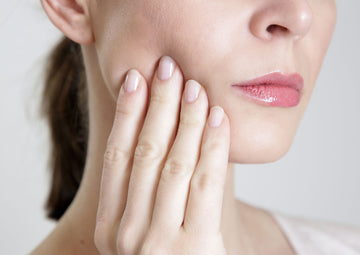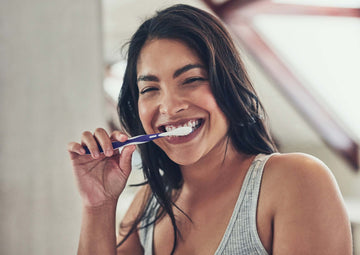

If you love coffee and red wine (who doesn’t?), odds are you may have noticed some discoloration on your teeth. This is normal. Over time, your mouth endures a variety of food, drinks, and substances that can cause stains on your teeth — even aging can stain your teeth!
If you’re unhappy with your current smile, you may have considered getting your teeth whitened. Tooth whitening is any process that can make your teeth appear whiter. Tooth stains can happen on the inside of the tooth (intrinsic) or the surface (extrinsic). But how exactly does teeth whitening work?
Whitening can be done with one of two ways: through physical removal of the stain or by a chemical reaction. Most whitening products include the active ingredient hydrogen peroxide — this can be delivered as carbamide peroxide or hydrogen peroxide. When this product is used to bleach teeth, the hydrogen peroxide oxidizes, causing the stain to lighten.
A lot of chemistry happens to make our teeth pearly white. If you’re confused by the process, don’t worry. We break down each teeth whitening method, how they work, whether they’re safe, and how soon you'll see results in our guide below.
1. In-Office Professional Teeth Whitening

One of the easiest ways to get your teeth whitened is to see a dental professional. The bleaching gel used by professionals usually includes carbamide and hydrogen peroxide. These cleaning agents get inside tooth enamel and break apart the compounds that cause stains.
Typically, in-office visits take around two hours and follow a process similar to the below.
- A cheek retractor made of plastic is placed in your mouth. This helps keep your mouth open for the duration of the process.
- A resin or liquid rubber dam is brushed onto your gums to protect against irritation.
- A bleaching gel containing 15 percent to 43 percent hydrogen peroxide is administered to your teeth and left on for about 15 to 30 minutes.
- The gel is washed off and a new coat is added on for another 15 to 30 minutes.
- During the process, your teeth will be checked periodically to determine whether or not more bleach needs to be added.
- If you have chosen a laser whitening treatment, a powerful light will be used to enhance the bleaching process. The use of lasers can increase the rate of chemical reactions — developing quicker results.
- Once done, the cheek retractors will be removed, you’ll rinse out your mouth, and look at your brand new smile!
Getting your teeth whitened professionally is the fastest way to see results. However, it is the most expensive option. For more dramatic results, you may need to go in a few more times.
At-Home Teeth Whitening Options

If you don’t want to pay for an in-office dental visit, try an over-the-counter teeth whitening product. Most at-home teeth whitening products provide professional-quality whitening that delivers strong results, without the added hassle of making a dentist appointment.
2. Whitening Strips
Tooth whitening strips are simple and effective. All you have to do is apply the strips to your teeth and leave on for the directed amount of time (usually 30 minutes).
Most whitening strips include hydrogen peroxide or carbamide peroxide. When the strips come in contact with your teeth, the hydrogen peroxide will oxidize and bleach the teeth — making them look much whiter. Most people will see results within a week or two.
3. Whitening Gels and Trays
Teeth whitening trays and gels are available both professionally and over the counter. Most whitening gels are peroxide-based and the trays used are made of a malleable material that molds to your teeth. The Auraglow professional whitening gel has 35 percent carbamide peroxide and remineralizing ingredients to whiten the surface of the teeth.
To use whitening gels and trays, put the gel into the fitted tray and place them on your teeth. Typically, these are worn for a couple of hours per day — users will typically see results in just a few short days.
4. Whitening Pens
Teeth whitening pens are easy and effective. Most pens are peroxide-based and can fight common extrinsic stains caused by coffee, tea, colored foods, red wine, and smoking. The Auraglow whitening pen uses 35 percent carbamide peroxide gel to help get those tough stains.
Whitening pens are one of the easiest ways to whiten teeth — you can even do it while running errands! Most pens are small and can fit in your purse or bag. All you have to do is twist the pen and brush the solution on the teeth you want to be whitened. To see the best results, use this product one to two times a day and avoid eating and drinking for an hour after.
5. Whitening Toothpaste and Mouthwash
Whitening toothpaste typically contains bleaching chemicals — such as hydrogen peroxide or carbamide peroxide — in order to remove extrinsic stains. These surface stains can be caused by drinking coffee or smoking. Whitening toothpaste can help whiten the color of your teeth by about one or two shades.
Whitening mouthwashes work similarly to whitening toothpaste. They include hydrogen peroxide to help remove stains. Most mouthwashes require you to wash two times a day for several months until you can start to see results.
Is It Safe to Whiten Your Teeth?
A big question people have before whitening their teeth is whether or not it’s safe. The short answer: it depends. Common risks associated with whitening are tooth sensitivity and mild gum irritation.
These risks are associated with the level of peroxide used and the length of the treatment. If you have sensitive teeth, a typical bleaching agent might be too harsh. There are products that cater to people with more sensitive teeth, however, it’s always a good idea to talk to your dentist beforehand.
How Quickly Does Teeth Whitening Work?
The results you see will depend on the teeth whitening method you choose.

- Professional teeth whitening: One appointment usually lasts 90 minutes and you can see results after one session.
- Whitening strips: Whiter teeth can be seen in one to three days.
- Whitening gels and trays: Results can be seen in one to three days.
- Whitening pens: Whiter teeth can be seen in four to eight days.
- Whitening toothpaste and mouthwash: When used regularly, results can be seen anywhere from two to six weeks.
Professional teeth whitening will produce the quickest results. However, if you’re on a budget and don’t feel like setting up a dentist appointment, consider choosing an at-home method, like whitening pens or whitening trays, that can show results in just a few days or weeks.
How Auraglow Works
Oral hygiene is a critical component of leading a healthy lifestyle. If you’re looking for quality whitening products that will deliver fast results, Auraglow offers powerful teeth whitening gels, pens, and kits that will brighten your smile in just a single treatment.
Auraglow products are made with no artificial colors so you can whiten the surface of your teeth without harmful side effects or pain. We believe that every smile is different and unique, so we’ve created a variety of teeth whitening products that can deliver results for every type of smile.
Source:




